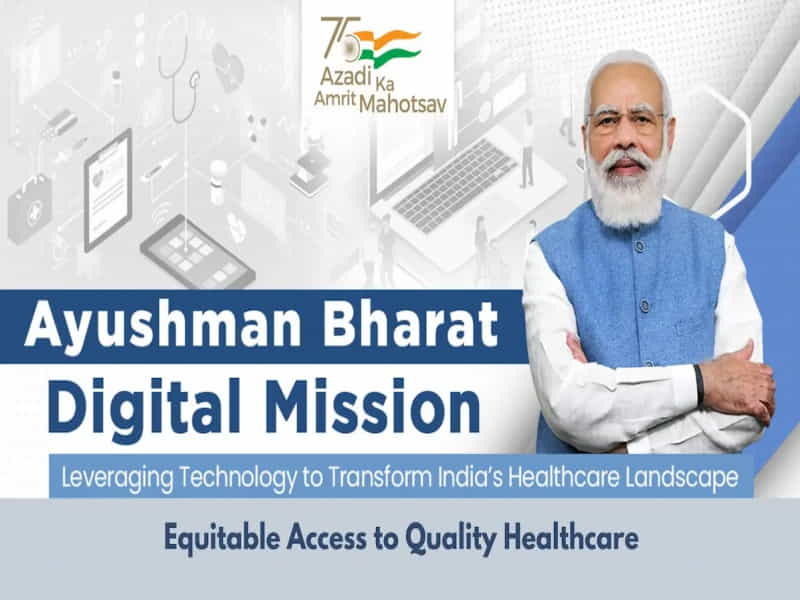Impact of Ayushman Bharat Digital
Mission on Indian Healthcare

The Ayushman Bharat Digital Mission (ABDM) is a transformative initiative by the Government of India to develop a comprehensive digital health ecosystem for the nation. At its core, ABDM seeks to establish a digital framework that supports the integrated digital health infrastructure of the country. This mission is designed to bridge the gaps among various stakeholders in the healthcare sector through digital highways, enabling a seamless flow of health information.
The Significance Of Digital Health In India
Digital health is of paramount importance in India, a country with a vast and diverse population with varying access to healthcare services. The advent of digital health technologies has the potential to revolutionise healthcare delivery by making it more accessible, affordable, and efficient. It addresses critical challenges such as the rural-urban disparity in healthcare infrastructure, the shortage of medical professionals, and the high out-of-pocket expenditure on health by the Indian populace. Digital health can empower patients to manage their health better and enable healthcare providers to deliver care more effectively.
Brief History & Evolution Of ABDM
The journey of ABDM began as the National Digital Health Mission and was rebranded to its current name. It was officially launched in September 2021, following a pilot phase that started in August 2020 across six Union Territories. The mission’s objective is to create a unified digital health ecosystem that enhances the efficiency, effectiveness, and transparency of health service delivery overall. ABDM is a step forward from the Ayushman Bharat Yojana, launched in 2018. It builds upon the vision of providing a digital health identity to every citizen and facilitating access to a standardised healthcare system across the country.

The ABDM is a bold step towards achieving universal health coverage and represents a significant milestone in India’s journey towards a more inclusive and technologically advanced healthcare system. Its success hinges on the collaborative efforts of all stakeholders, including the government, healthcare providers, and the citizens of India. As ABDM evolves, it promises to bring about a paradigm shift in how health services are delivered and experienced in India.
Objectives Of ABDM:
1. Creating a Digital Health Ecosystem: ABDM seeks to establish a unified platform where health data and services can be accessed digitally, making healthcare more cohesive and efficient.
2. Integrating Various Health Services: It aims to connect different health services, from hospitals to diagnostic labs, creating a seamless health service network.
3. Providing a Unique Identity to Citizens for Health Records: Each citizen will receive a unique health ID, which will serve as a key to their health records, ensuring easy and secure access to their medical history.
Components Of ABDM:
1. Unique Health ID: At the core of ABDM is the Unique Health ID, which standardises individual identification across healthcare providers. This ensures that medical records are correctly assigned and accessed, with the individual’s consent, facilitating a seamless healthcare experience.
2. Healthcare Professionals Registry: This registry is a comprehensive directory of healthcare professionals nationwide. It serves as a verification source for the credentials of healthcare providers, ensuring that patients receive care from qualified individuals.
3. Health Facility Registry: Similar to the Healthcare Professionals Registry, this component maintains a detailed list of health facilities, including hospitals, clinics, and laboratories. It provides a verified source of information about healthcare infrastructure.
4. ABHA Mobile App (Personal Health Records): The ABHA Mobile App enables individuals to access and manage their health records. It empowers patients to control their health data and share it with healthcare providers as needed.
Benefits Of ABDM:
1. For Patients: Improved access to medical records, easier health services navigation, and personalised healthcare.
2. For Healthcare Providers: Streamlined patient management, reduced paperwork, and enhanced treatment capabilities.
3. For the Healthcare Industry: A more efficient healthcare delivery system, better data management, and the potential for advanced health analytics.
Implementation Of ABDM:
The NHA has proactively rolled out the ABDM, with a budgetary allocation of Rs 1,600 crore over five years, to support the mission’s implementation. As of early 2022, a significant number of health IDs have been created, indicating widespread adoption and integration into the health ecosystem.
The implementation of ABDM involves several stakeholders, including the central government, state governments, Union Territory administrations, and district administrations, each playing a crucial role in the deployment and governance of the mission. The National Health Authority leads the initiative, providing guidelines, financial assistance, and support to the states and UTs for human resources, information education & communication (IEC), and capacity building.
Challenges Of ABDM
1. Infrastructure: One of the significant hurdles is the infrastructure of the health system in India, especially in rural areas where internet and computer facilities are scarce.
2. Digitization: The inadequate digitisation of existing health records poses a challenge to integrating and streamlining health services.
3. Privacy and Security: Ensuring the privacy and security of health data is paramount, and building trust among citizens is crucial for the success of ABDM.
4. Stakeholder Engagement: Limited involvement of private players has been observed, which is essential for the mission’s widespread adoption and success.
Solutions & Progress
1. Infrastructure Development: Efforts are underway to enhance internet connectivity and computer access, particularly in remote areas, to support the ABDM infrastructure.
2. Digital Literacy: Initiatives to improve digital literacy among healthcare providers and citizens are essential for the effective use of ABDM services.
3. Data Protection: The mission incorporates robust frameworks to safeguard personal health information and build public trust.
4. Public-Private Partnerships: Encouraging the participation of private healthcare providers to create a more inclusive digital health ecosystem.
Conclusion:
The Ayushman Bharat Digital Mission (ABDM) represents a transformative approach in India, aiming to create a unified digital health ecosystem that simplifies processes and enhances the patient experience. This vision aligns seamlessly with the objectives of the CarePal Secure Health Protection Plan, which offers comprehensive health coverage with benefits like 24/7 teleconsultation, discounts on pharmacy and diagnostics, and personal accident insurance.Together, these initiatives can potentially revolutionise healthcare by providing a seamless, secure, and accessible digital health environment. This synergy could lead to a more inclusive healthcare system where digital empowerment and health protection go hand in hand, ensuring a healthier future for all citizens.
Frequently Asked Questions
Good digestion ensures proper nutrient absorption, strengthens immunity, and boosts energy levels. It also prevents complications like weight gain, hormonal imbalances, and chronic diseases.
Consider the insurer’s financial stability, claims process, coverage terms, and inclusion of services like teleconsultation and diagnostic tests. These factors ensure smooth access to care and timely claim settlements.
Poor digestion can cause nutrient deficiencies, weakening the immune system and leading to fatigue. It’s also linked to weight gain, diabetes, and mental health issues.
Adopt a balanced diet rich in fiber and fermented foods, quit smoking, avoid alcohol, exercise regularly, and manage stress to support healthy digestion.
It offers comprehensive benefits, including hospitalization, diagnostic tests, and teleconsultation, with a reduced waiting period for pre-existing conditions and cashless treatments.
Hi, my name is Om, and I am a developer at Carepal Secure. With a strong passion for technology and innovation, I enjoy creating effective solutions and learning new skills to enhance my expertise. My journey in development has been both challenging and rewarding, allowing me to grow professionally while contributing meaningfully to the projects I work on.












